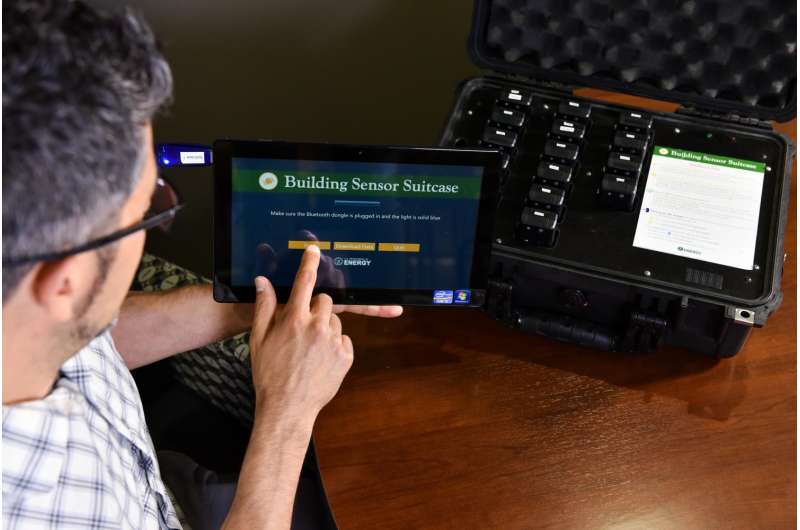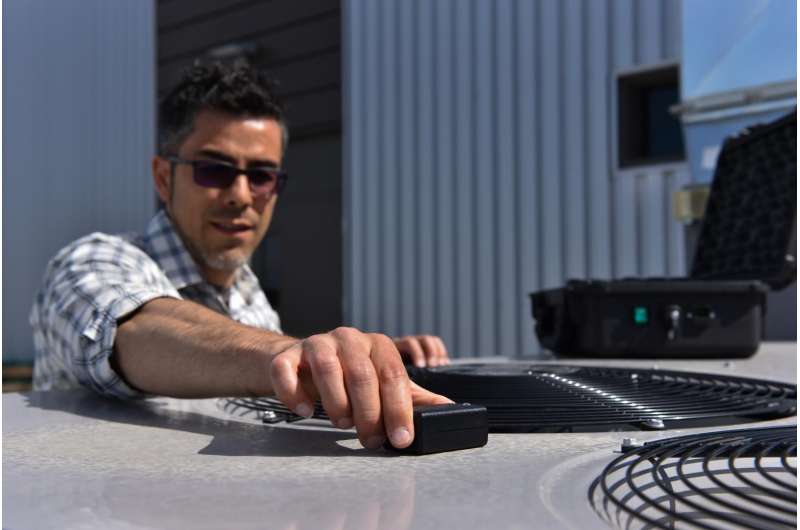'Expert in a suitcase' cuts power bills 10 percent in small commercial buildings

The knowledge and expertise of a seasoned energy efficiency professional has been packed into a high-tech suitcase.
The Sensor Suitcase is a portable case that contains easy-to-use sensors and other equipment that make it possible for anyone to identify energy-saving opportunities in small commercial buildings. The automated and reusable system combines hardware and software in one package so its users can identify cost-effective measures that save small commercial buildings about 10 percent on their energy bills.
Jointly developed by two Department of Energy labs, Pacific Northwest National Laboratory and Lawrence Berkeley National Laboratory, the Sensor Suitcase has been licensed by two companies that plan to provide products or services based on the technology. The licensees are GreenPath Energy Solutions and Cultural Quotient.
"Most small commercial building owners believe it costs too much to make their facilities significantly more energy efficient," said scientist Michael Brambley, who led PNNL's development team. "But the Sensor Suitcase system can change that. It helps someone with minimal training collect and automatically process building data, which the system uses to generate specific recommendations to improve energy efficiency. The U.S. could reduce its national energy costs by about $5.1 billion if all small commercial buildings used this technology."
Implementing energy efficiency measures in small commercial buildings has been notoriously difficult, said mechanical engineer Jessica Granderson, who led Berkeley Lab's development team.
"The real innovation is in the streamlining," said Granderson, who is also a deputy director of Berkeley Lab's Building Technology and Urban Systems Division. "It's kind of like the 'for dummies' version of how to identify improvements in your building. Instead of hiring a professional engineer to conduct a full energy evaluation, you could get just about anyone to do it."
The Sensor Suitcase is designed to reduce energy use in existing buildings by finding ways to improve the way they operate, a practice energy-efficiency professionals call "retro-commissioning." Large commercial buildings often have the resources needed for retro-commissioning, while smaller buildings with 50,000 square feet or less don't. PNNL and Berkeley Lab developed the Sensor Suitcase to overcome that hurdle.
How it works
Inside the suitcase sit 16 pocket-sized sensors that can measure three things: temperature, whether lights are on or off, and how a heating and cooling system is operating. Users follow clear instructions from the Sensor Suitcase's operations software, which runs on a separate tablet, to install sensors inside a building.
About a month later, users gather the sensors and return them to the suitcase, which users then connect to a personal computer so they can transfer the collected energy data. The system's unique analytical software is used to automatically crunch the sensor data, eliminating the need to hire a professional to manually plot, inspect and interpret data.
The final result is a report that identifies problems (such as excessive lighting), recommends low- and no-cost ways to fix problems (such as installing occupancy sensors that turn lights on only when a room is being used), and provides estimated cost savings for addressing each problem.

Improvements
The Sensor Suitcase system focuses on eight of the most common and cost-effective areas to improve energy efficiency in small commercial buildings. As a result, it can help building owners save about two-thirds of the energy that can be saved with the traditional approach to retro-commissioning, which requires the hands-on labor of several energy-efficiency professionals, who are often engineers. Conducting a traditional retro-commissioning assessment takes six months or longer, while doing the same assessment with a Sensor Suitcase takes four to six weeks and costs about a third of traditional retro-commissioning services.
Small building owners can buy and use the Sensor Suitcase themselves, but it will likely be more practical for them to hire an outside company that provides services based on the technology. Additionally, utilities could lend the technology to commercial building-owning customers or otherwise encourage its use. Though the Sensor Suitcase is intended for small commercial buildings, it could also be used to supplement energy retrofits at large commercial buildings.
Heading to the market
GreenPath Energy Solutions of Orlando, Fla., a provider of energy-efficient building solutions, will offer both a product and services with the Sensor Suitcase technology. The company helps facility managers and building owners control their operational, energy and facility costs by providing energy auditing, retro-commissioning and software solutions. GreenPath plans to market its product and services to federal, state and local governments through its GSA Schedule contract with the General Services Administration.
Cultural Quotient of Arlington, Va., will offer a product based on the technology. The company will make and sell its product as a partner with the manufacturing firm Zepher, Inc., of Bingen, Wash. CQ Corporation is also partnered with the Chicago-based nonprofit Invent2026 to sell CQ's Sensor Suitcase-based product to local and state government entities in the Midwest, as many small businesses lease or occupy local government-owned buildings.
Both licenses are non-exclusive, meaning the Sensor Suitcase technology is also available for other companies to license.
Provided by Pacific Northwest National Laboratory




















